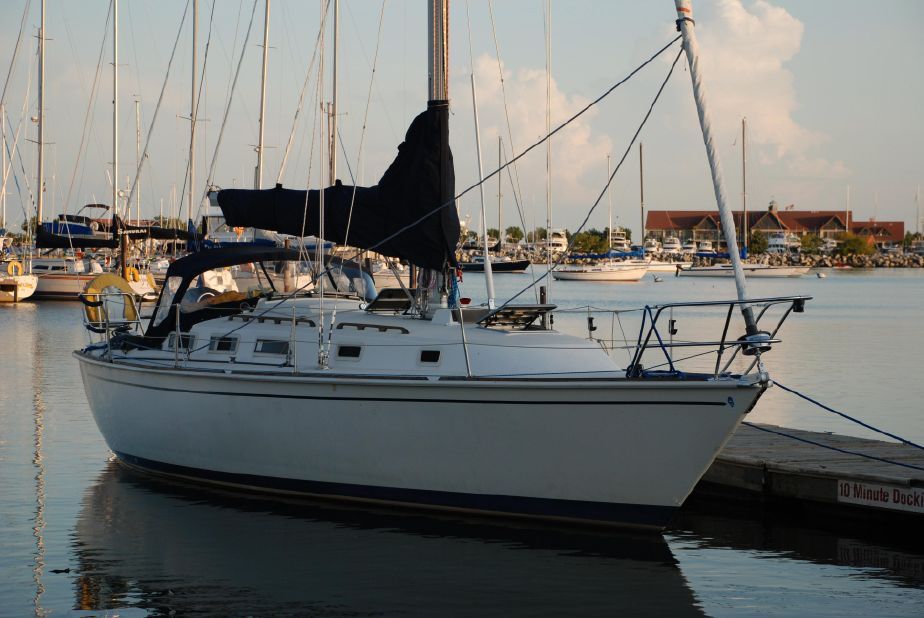For many sailors looking to looking to move up in size, boats in the 36-foot range offer, to borrow a phrase from Goldilocks, the not-too-big, not-too-small, but just the right size. Boats in this range are easily handled by a couple yet provide sufficient space for a family as well as some of the creature comforts we aging sailors have come to enjoy. So, it’s no surprise that just about every production sailboat builder I can think of offers a model in this range. The 36-2 was Pearson’s mid-to-late 1980s choice to fill this market niche and, despite the name, the fifth and last of their 36-footers.
The 36-2’s styling certainly dates her to the 1980s time frame, but she remains a good looking, albeit conservative, design. Length overall is 36’ 6”, the designed waterline length is 29’ 7”, and beam is 12’ 4”. Two underbody configurations were offered—a fin keel drawing 6’ 6” and a keel/centerboard option drawing 4’ 2” with the board up and 8’ 3” with the board down. Displacement of the fin keel model is 15,000 pounds with an extra 850 pounds for the keel/centerboard model to offset the slightly higher center of gravity.
The hull is constructed of a solid laminate of fiberglass cloth and plastic resin, while the deck and cabin structure utilize end-grain balsa core between fiberglass laminates for added strength and rigidity. The structure is supported by a combination of plywood bulkheads, longitudinal stringers, and fiberglass liners. The deck and hull are joined with through bolts on an outward flange covered by a plastic molding, and although susceptible to damage by minor collisions with docks and pilings, is otherwise strong and secure.
The quality of construction and finish is a step above that of entry-level production builders, and these boats have very few problems other than those caused by neglected maintenance. It is quite common to find moderate to occasionally severe osmotic blistering of hull bottoms that have not been barrier coated or undergone some remedial repair. Although a thorough, professional blister repair is expensive—likely $7000 to $10,000—it may make sense for owners planning to keep a boat long enough to amortize the cost.
In order to maximize accommodations below deck, the cockpit of the Pearson 36-2 is quite small; although, four adults can be seated in comfort. Wheel steering is standard, and there is a deep locker in the port cockpit seat. The stern rail is split for easy access to the transom-mounted folding swim ladder. The teak toe rail along the side deck is not large enough to serve as a comfortable foot hold. The foredeck is unobstructed with separate anchor locker at the bow to keep damp anchor lines from smelling up the cabin below.
Sailors moving up from the 26- to 30-foot size range are likely to find the interior arrangements of the 36-2 downright luxurious. The v-berth cabin provides privacy, standing headroom, and enough space to dress and change in comfort. There is a good-sized hanging locker to starboard and a chest of drawers to port. The main saloon has a U-shaped dinette to starboard, which will seat five adults and converts to a double berth, with a comfortable settee to port. The L-shaped galley is aft of the dinette and has a double sink, top-loading ice box, and propane stove and oven. Because the engine is below the galley counter, storage space is somewhat limited.
Opposite the galley is a small navigation station followed by a wet locker and then by a head/shower. Some would prefer a separate shower stall on a 36-footer but, for that, Pearson would have had to give up the navigation station and wet locker.
To starboard aft is a quarter berth cabin with a truly queen-sized double berth and another hanging locker. Although the berth is large, half of it is beneath the cockpit with very limited overhead clearance. No claustrophobics please.
Auxiliary power is provided by a 30-horsepower Yanmar diesel mounted near the longitudinal center of gravity beneath the galley counter. Despite the intrusion on galley storage and proximity to the top-loading ice box, this is the preferred location for an auxiliary engine.
If one word could be used to describe the sailing performance of Bill Shaw’s designs, it would be predictable. All of Shaw’s designs that I have ever had a chance to sail were well balanced, without quirky sailing characteristics, and the 36-2 is no exception. Her sail area/displacement ratio of 17.5 and displacement length ratio of 259 are quite conservative by 2008 standards but typical of mid-1980s cruising designs. Her 2004 PHRF rating was 138 for the deep-keel version, which compares to the more racer/cruiser-oriented J/36 at 84 or the cruising-oriented Catalina 36 at 144.
In July 2008, 11 Pearson 36-2s were for sale at the yachtworld.com website with asking prices ranging from $65,000 to $79,500. Of seven reported sales over the last year, the average reported selling price was $67,200.
The Pearson 36-2 has maintained its popularity over the years not only for her size and accommodations but for Pearson’s reputation for above-average quality, good sailing characteristics, and value.
Specifications:
LOA 36’ 6”
LWL 29’ 7”
Beam 12’ 4”
Displacement 15,000 lbs Fin Keel
15,850 lbs K/CB
Draft 6’ 6” Fin keel
4’ 2” – 8’ 3” K/CB
Reviewed in the September 2008 issue of SpinSheet by Jack Hornor





